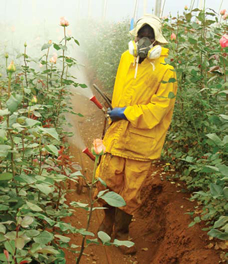 With the world’s human population expected to reach nearly 10 billion by 2050 and the negative impact of climate change on agriculture, maintenance of a stable global food supply is under significant threat.
With the world’s human population expected to reach nearly 10 billion by 2050 and the negative impact of climate change on agriculture, maintenance of a stable global food supply is under significant threat.
Industry trends (company consolidation, regulatory trends) As mentioned above, even though the crop protection market has grown significantly, leading agrochemical companies have entered a period of significant consolidation. There were more than ten major agrochemical companies in the United States (US) and Europe in 1990, but the number of these business entities dropped to six majors by 2009 through mergers and acquisitions (M&A), namely Syngenta, Bayer, BASF, Dow Chemical, DuPont and Monsanto. These six companies subsequently reorganized in response to poor business performance, the surge of R&D expenses due to tighter regulations on new agrochemical registration, expectations from stock holders for the realization of a new growth strategy and other factors. Most recently, through further consolidation activities, the six majors are now down to Bayer, DowDuPont (now Corteva), BASF, and Syngenta, which is now under the umbrella of the China National Chemical Corporation (commonly known as ChemChina). In 2017, FMC Corporation acquired a sizable portion of DuPont’s crop protection business and R&D assets that DuPont had divested upon a merger with Dow Chemical. As such, the crop protection market has entered an age of five major players; that is, the abovementioned four companies plus FMC Corporation. From here, we examine the situation of agrochemical R&D and the impetus behind the corporate reorganization and consolidation from several perspectives. The first involves reaffirming the contribution of agrochemicals to agricultural production. According to an article written in 2006, maximum achievable yields in rice, wheat, maize and soybean may decrease by ca. 20–50% without the proper use of agrochemicals. On the other hand, using agrochemicals can recover the yield by up to 60–70%. Thus, it is clear that the current level of crop production is attainable only with appropriate use of agrochemicals, without which the crop yield would drop dramatically. The same article also explains that more effective use of agrochemicals could lead to a further increase in crop yield, creating expectations for further technical improvement.
While agrochemicals have been making a huge contribution toward the enhancement of crop productivity as just described, it is becoming ever more difficult to develop agrochemicals. It takes over ten years and R&D expenditure of $100–350 million to develop and market a new agrochemical, and the process involves: discovering a new agrochemical candidate; conducting safety studies, biological studies, and formulation research in parallel; comprehensively evaluating the results from these studies; and finally applying for and obtaining registration as an agrochemical. Moreover, because of various factors mentioned later, currently the probability of obtaining a new agrochemical is estimated as one in around 160 thousand compounds. As such, each company developing agrochemicals has to invest 7–10% of its sales in R&D activities every year. What is more, the cost and time required to develop agrochemicals have been increasing each year. For example, in 1995, the development expense was 152 million dollars and R&D time was 8.3 years; however, according to a survey conducted from 2010 to 2014, these same metrics increased to 286 million dollars and 11.3 years, respectively, suggesting that such a hike in the R&D burdens is one of the factors driving consolidation of companies involved in agrochemical R&D as mentioned above.
 Furthermore, “development” costs are rising quickly for environmental and toxicity studies, and field trials, which are conducted in the latter stages of development. The impetuses behind these cost increases are a growing demand for safer agrochemicals and tightening regulations by relevant authorities. As if reflecting recent difficulties in agrochemical R&D activities, the number of new agrochemicals launched into the market peaked in the 1990s and has declined since the 2000s, illustrating the harsh conditions for new agrochemical development.
Furthermore, “development” costs are rising quickly for environmental and toxicity studies, and field trials, which are conducted in the latter stages of development. The impetuses behind these cost increases are a growing demand for safer agrochemicals and tightening regulations by relevant authorities. As if reflecting recent difficulties in agrochemical R&D activities, the number of new agrochemicals launched into the market peaked in the 1990s and has declined since the 2000s, illustrating the harsh conditions for new agrochemical development.
Nevertheless, even in this difficult environment for agrochemical R&D, research activities at Japanese agrochemical companies remain relatively strong. Although sales by the Japanese companies are smaller than those by the major players in the US and Europe, ten Japanese companies have ranked within the top twenty with the highest numbers of newly marketed products (from 1980 to 2016). During the same period, among the 363 newly marketed agrochemicals worldwide, 114 (31%) were developed by Japanese companies. Even in the ever tougher environment for R&D, for example, in 2016, Japanese companies accounted for approximately 40% of the later R&D stage agricultural chemicals. Thus, it is safe to conclude that the R&D capability of Japanese companies to launch new chemicals is very high and comparable to that of the leading companies in the US and Europe.
The application rates of agrochemicals, which require a lot of time and effort to market, were ca. 2,400 g of active ingredient per hectare (gai/ha) for herbicide, ca. 1,700 gai/ha for insecticide, and ca. 1,200 gai/ha for fungicide in the 1950s. By the 2000s, however, these application rates declined to 60–180 gai/ha,8) clearly demonstrating the superior performance (increased activity) of active ingredients in newly developed agrochemicals. Safety was another beneficiary; around 1960 in Japan, about the half of the agrochemicals were categorized as Specified Poisonous Substances or Poisonous Substances. However, by 2014, the number of such agrochemicals decreased sharply and nowadays nearly 90% of agrochemicals are categorized as Ordinary Substances.
 Furthermore, many biological pesticides are currently under development that are supposed to have less impact on the environment and a better safety profile (a biological pesticide is defined as a pesticide whose active ingredients are derived from living organisms. In a narrower sense, this includes only living things themselves, such as natural-enemy insects, while in a broader sense, the definition can also include substances extracted from microorganisms and the like. A review of new crop protection products marketed by year revealed that the number of chemical pesticides gradually began to decline from the 1990s, whereas the number of biological pesticides started to increase from the 1980s and averaged approximately ten new biological pesticides have entered the market per annum from the 1990s to the present.
Furthermore, many biological pesticides are currently under development that are supposed to have less impact on the environment and a better safety profile (a biological pesticide is defined as a pesticide whose active ingredients are derived from living organisms. In a narrower sense, this includes only living things themselves, such as natural-enemy insects, while in a broader sense, the definition can also include substances extracted from microorganisms and the like. A review of new crop protection products marketed by year revealed that the number of chemical pesticides gradually began to decline from the 1990s, whereas the number of biological pesticides started to increase from the 1980s and averaged approximately ten new biological pesticides have entered the market per annum from the 1990s to the present.
It is noteworthy, however, that the market size for biological pesticides is still relatively small, accounting for 5.6% of the whole crop protection market in 2016, revealing that sales of individual products are only modest.
